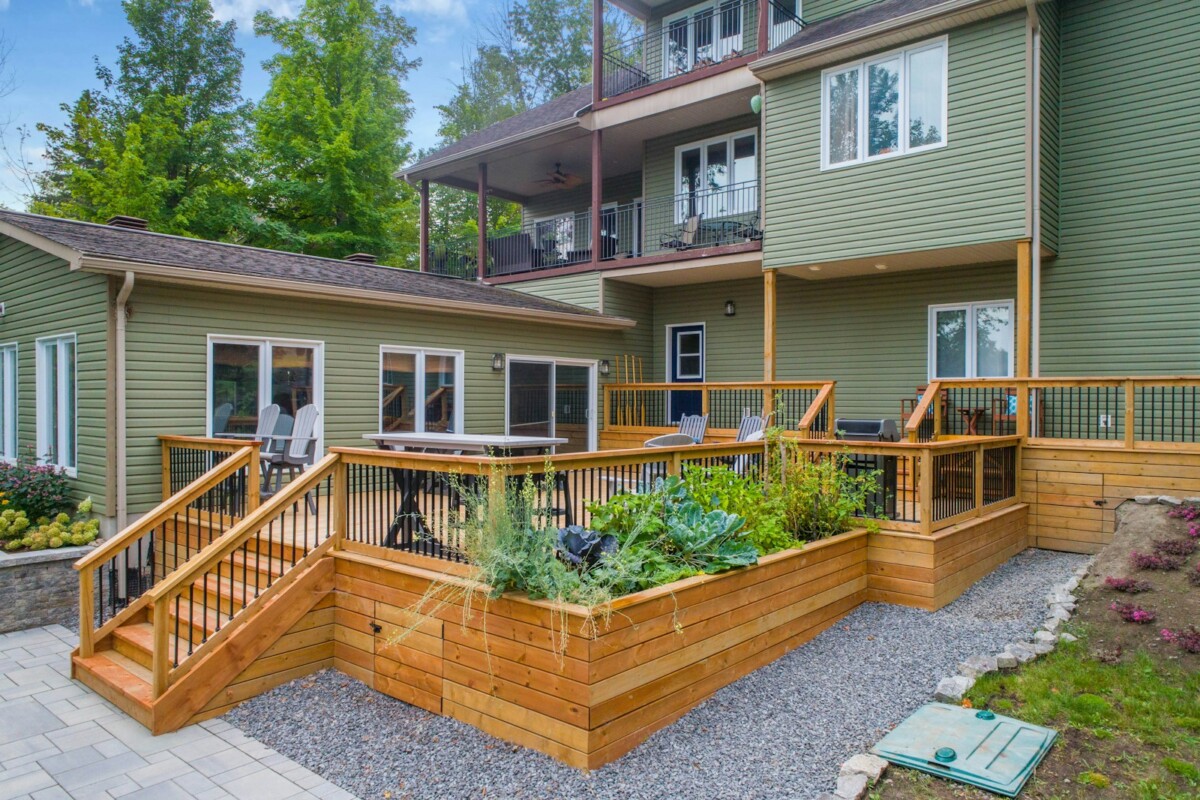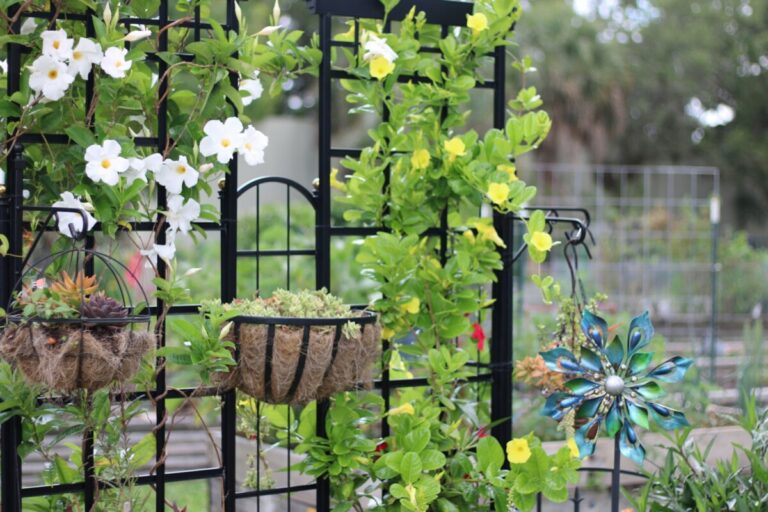Deck skirting doesn’t just hide the undercarriage of a platform; it frames the entire outdoor room. Done right, it solves practical problems—pest control, storage, ventilation—while giving your space a tailored finish that feels intentional. Below you’ll find Best Deck Skirting Ideas drawn from real-world details and refined design thinking.
I’ll walk through materials, maintenance quirks, cost clues, and pairing advice so you can pick a look that fits your backyard without fuss. Along the way, I’ll touch on deck skirting materials, show how each idea complements broader backyard deck design goals, and note when to lean toward low-maintenance deck skirting options or budget-friendly deck skirting ideas that still look high-end.
1. Brick Deck Skirting
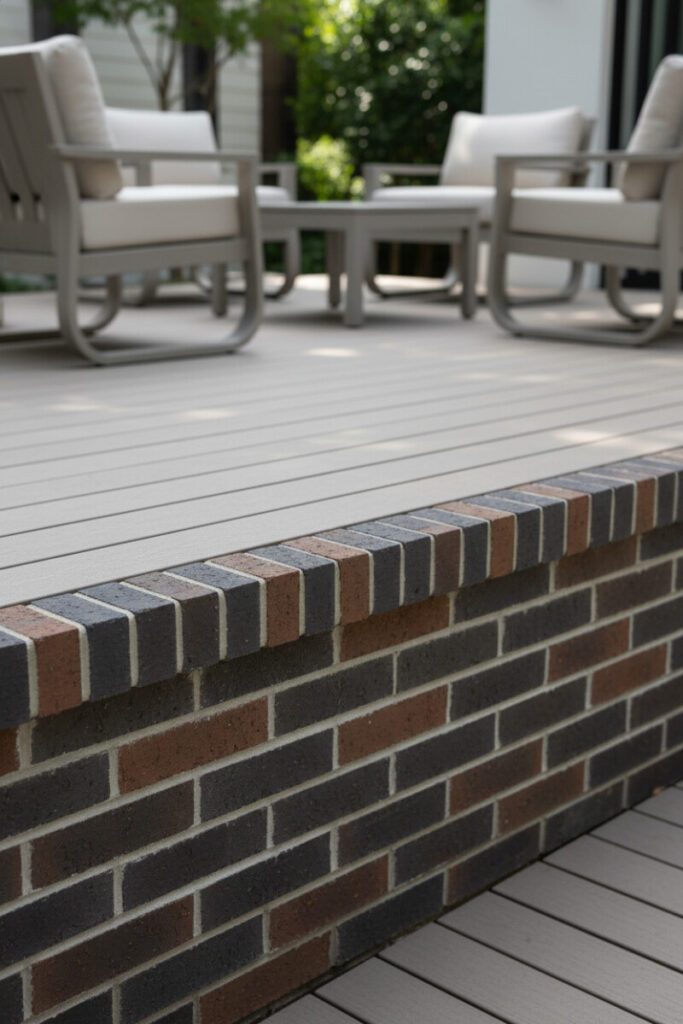
Brick is the quiet classic: solid, timeless, and reassuringly permanent. A low retaining wall of Roman brick—slimmer and slightly elongated—creates a refined base that reads like true architecture rather than a tacked-on skirt. When laid in a stretcher bond with crisp mortar joints and topped with a darker soldier-course cap, it finishes the deck the way trim finishes a room.
Brick excels where the grade changes or where you want a substantial foundation feel. It’s durable, pest-proof, and forgiving of the occasional bump from a mower. Pair it with composite or wood decking in taupe or driftwood gray for a subtle material play. Ventilation is easy: leave louvered grilles at intervals or tuck discreet, color-matched vent blocks into the field.
Care tips: Use breathable sealers in freeze–thaw climates, and run a gravel strip at the base to keep splash-back grime off the face. If you like lighting, set tiny recessed step lights in the soldier course; brick loves warm color temperatures.
2. Composite Decking Boards
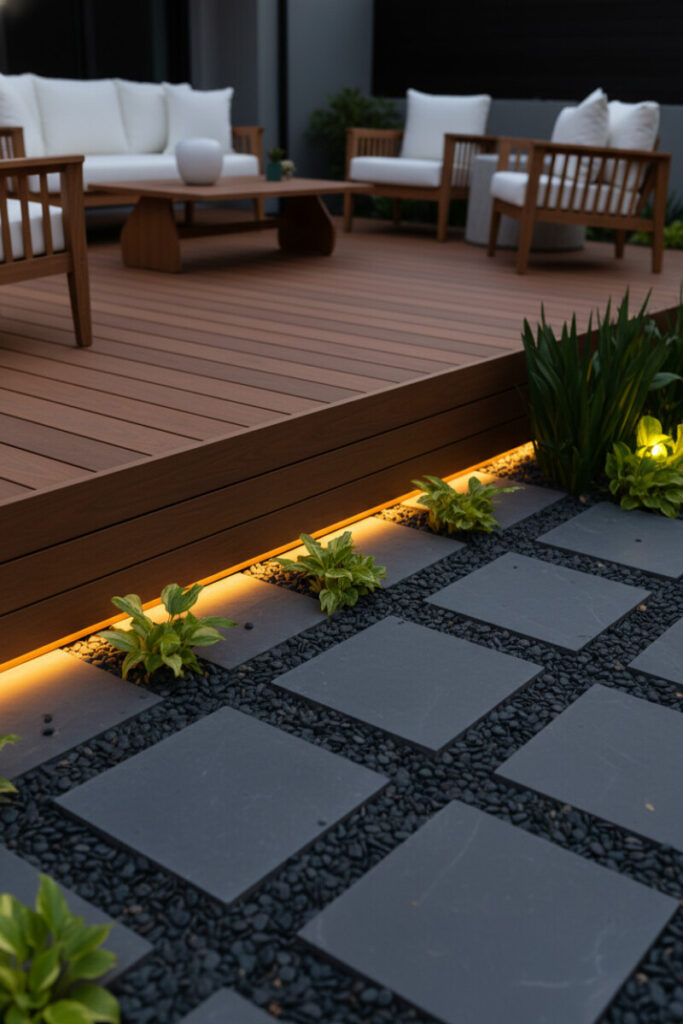
Using the same decking product as your skirting unifies the structure visually. Wide composite boards installed horizontally with minimal gapping deliver a smooth, contemporary apron around the deck. The continuity is especially striking at twilight when a warm LED strip washes down the fascia. Composite’s strength is predictability—no splinters, no tannin bleed, and colorfast planks that won’t gray out like natural wood.
Design cue: Introduce contrast at ground level with a matrix of large slate or bluestone pavers set in polished river pebbles. This blend of hard and soft edges anchors the base and subtly reflects the deck’s grain. If you need access to utilities, integrate a hinged panel on hidden fasteners to keep the face seamless.
3. Composite Fascia Boards
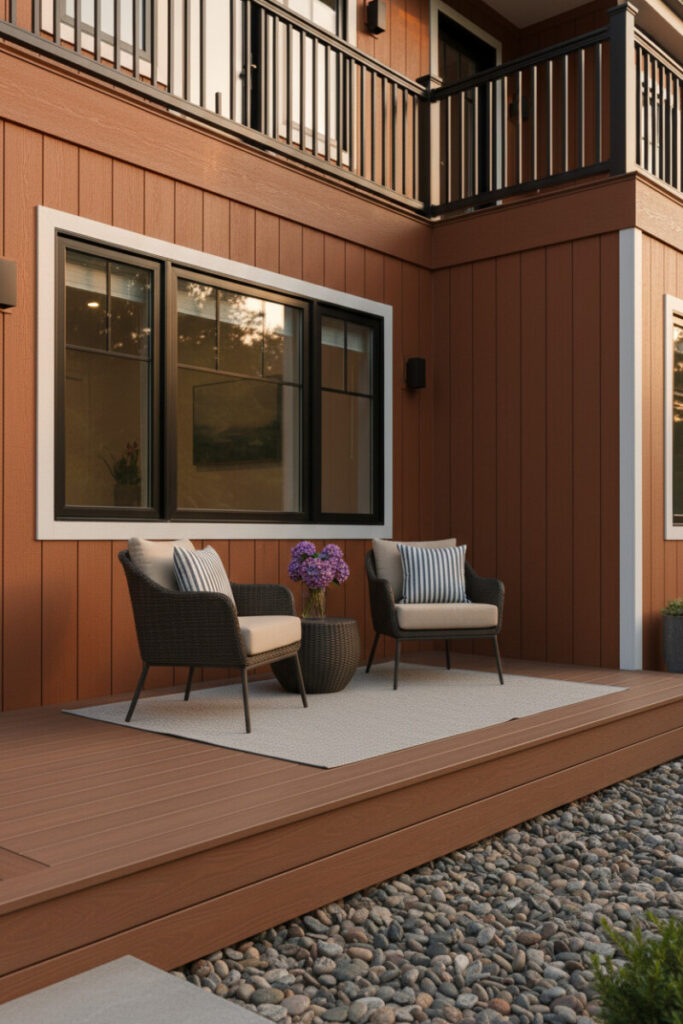
Fascia boards are the dress clothes of a deck. They wrap the exposed edges—including step risers and perimeter beams—so the structure reads crisp and finished. Using dedicated composite fascia, slightly deeper than standard planks, creates a one-piece look that’s easy to keep clean. In elevations where your deck sits 18–30 inches above grade, the fascia can run continuously with very tight reveals; for taller installations, break the height into a base course and a cap to avoid the “monolithic” look.
Pro move: Miter outside corners and protect them with a color-matched metal edge to prevent scuffing. Where the fascia meets stone or gravel, leave a ½-inch shadow line for ventilation and to avoid trapping moisture.
4. Corrugated Metal Skirting
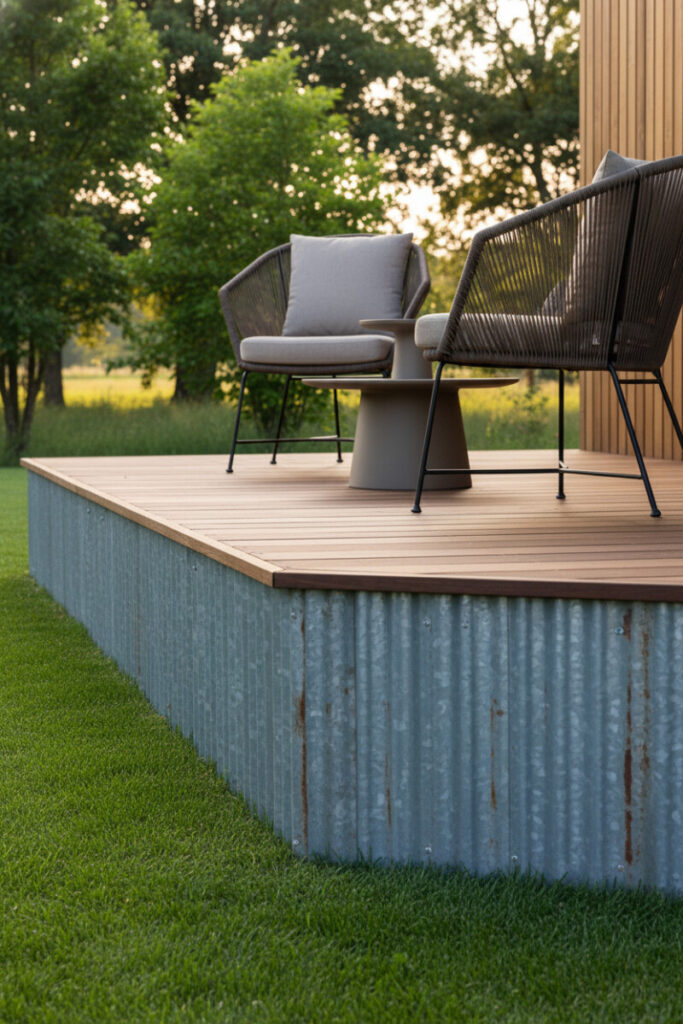
Corrugated galvanized steel brings a rustic-modern vibe that’s both textured and unexpectedly elegant. Installed vertically, the ribs amplify shadow, so even soft light reads dramatic. The material is inexpensive per square foot, tough against weed trimmers, and surprisingly quick to install with color-matched screws over a simple pressure-treated frame.
Pairing: Light, natural deck boards + matte black chair legs + woven seating equals a clean mix of warm and cool. Consider adding a cedar header board at the top to soften the industrial edge. Keep 3–4 inches of clearance to the soil and run landscape fabric plus gravel to prevent splash rust and keep the line neat.
5. Dark Wood Deck Skirting
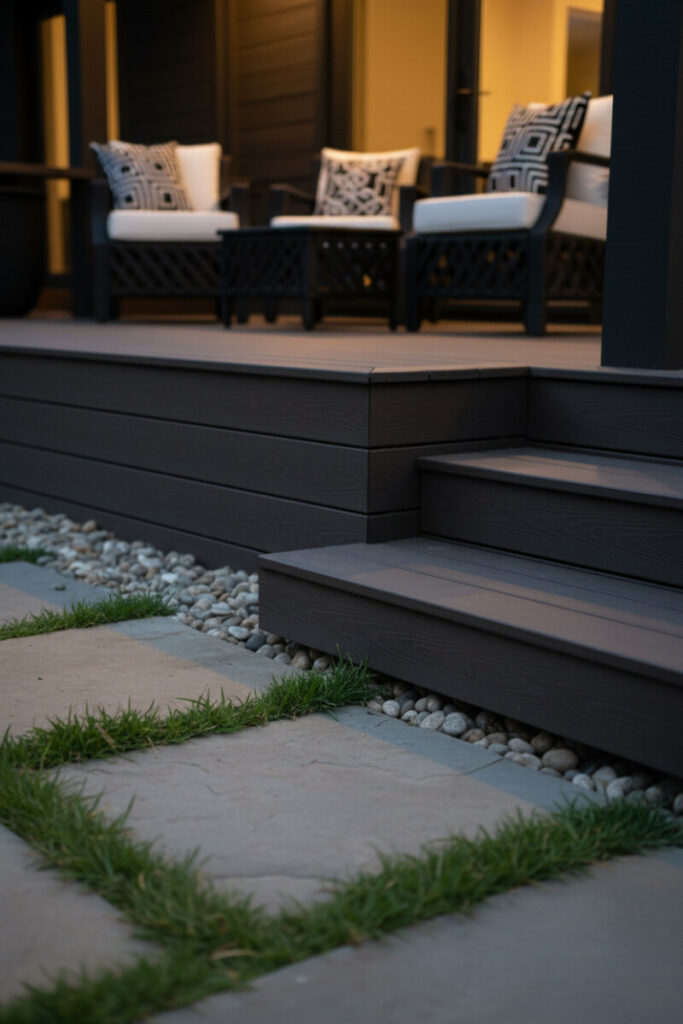
Deep espresso or cocoa-toned skirting is moody in the best way. In twilight, dark composite or stained wood risers disappear, making underlighting and pale paving pop. This approach works beautifully where ornamental grasses or flagstone steps weave into the deck’s edge—green blades against dark boards are a simple, high-contrast win.
Maintenance: For real wood, choose a penetrating oil stain and plan on touch-ups every 2–3 seasons. For composite, a quick soap-and-water rinse restores the matte grain. Either way, trim the base with river pebbles to visually finish the transition and aid drainage.
6. Deck Skirting Stairs
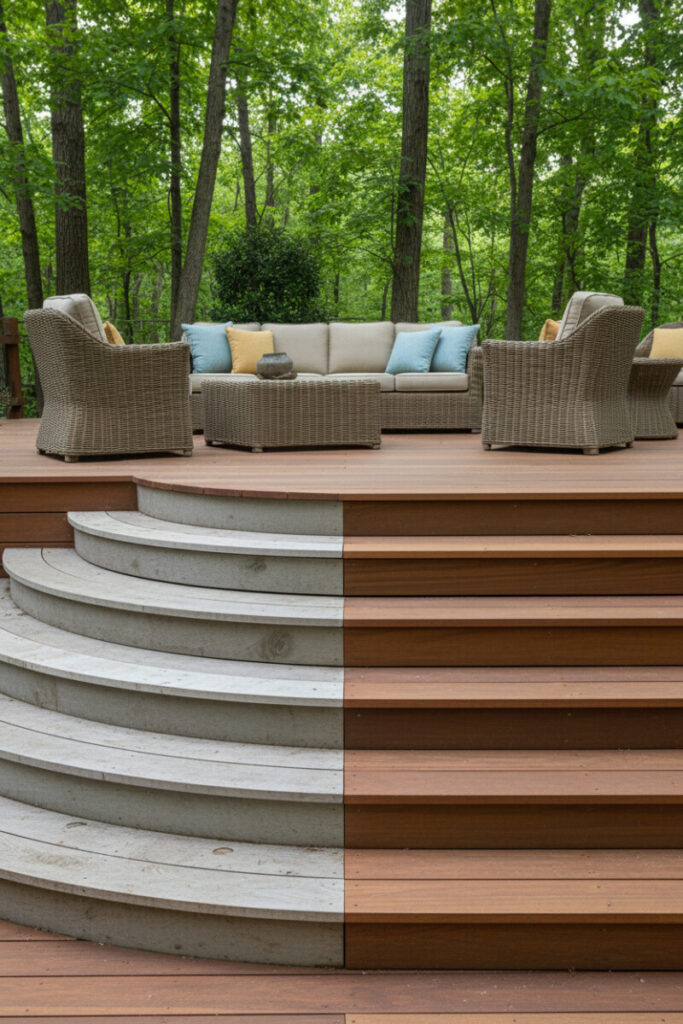
Sometimes the stairs are the skirt. If your deck changes elevation in a visible spot, treat the staircase as a sculptural element—curved treads to one side, straight runs to the other—to create a gentle “S” of movement. Contrasting woods (weathered gray vs. warm mahogany) make the geometry legible from a distance and help guests intuit where to step.
Build notes: Use beefy stringers and a consistent nosing detail for safety. Keep the risers ventilated with discreet slots or choose perforated riser panels to reduce echo under the steps. Potted planters staged along the rise soften the mass and draw the eye upward.
7. Deck Skirting with Lights
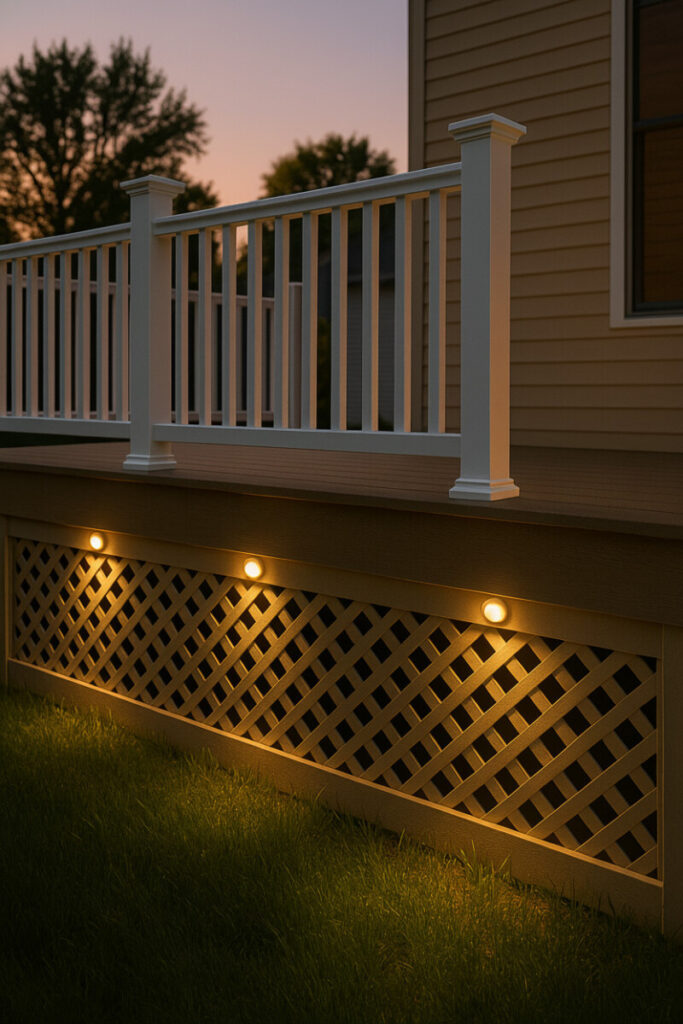
Integrated lighting earns its keep after sunset. Recessed puck lights or a continuous LED cove highlight lattice, panels, or fascia and cast a gentle glow onto plantings. Aim for 2700–3000K color temperature—warm enough to flatter wood and stone without veering orange. Place fixtures higher than you think (often in the upper fascia) to avoid glare in seated sightlines.
Safety & wiring: Use low-voltage systems with weatherproof connectors. Plan an accessible junction box behind a removable skirt panel; you will thank yourself later if a driver needs swapping. Timers or app-controlled dimmers prevent the “airport runway” look.
8. Deck Skirting with Storage
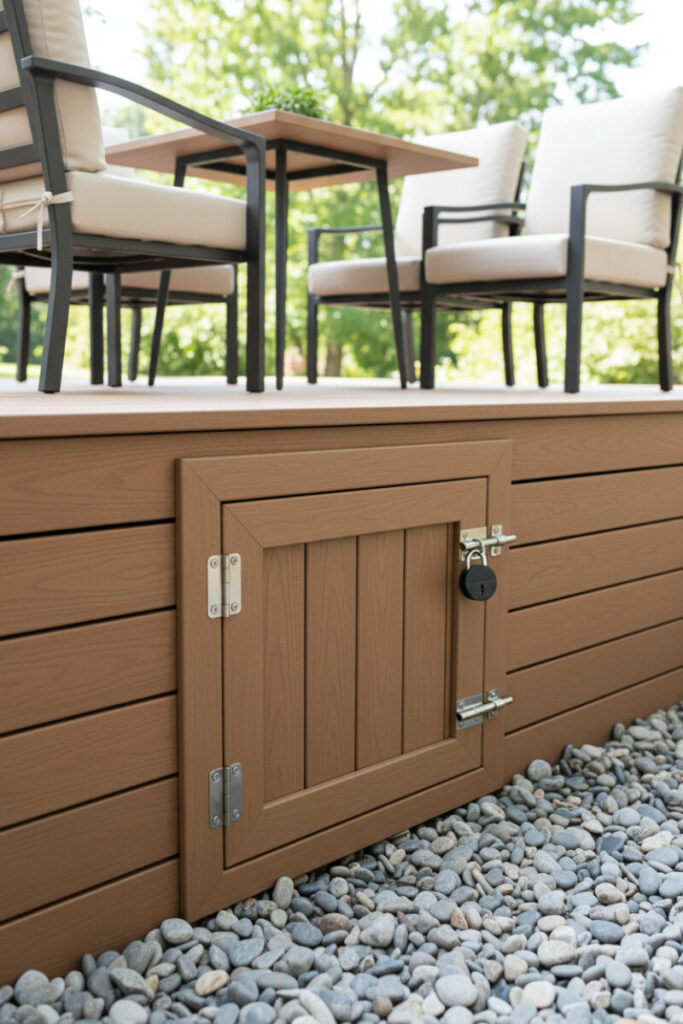
An access door turns empty under-deck space into a gear garage for cushions, planters, or hoses. Build the door from the same composite or wood as the surrounding skirt, then hang it on stainless T-hinges with a clean hasp. Keep the door just proud of the frame so rain sheds, and add magnetic catches to keep it snug in wind.
Moisture control: Lay down a simple vapor barrier plus pea gravel inside the storage bay and vent opposite sides of the skirt. For larger spans, upgrade to sliding barn-style doors on a low-profile track—the face stays orderly and you minimize swing clearance on tight patios.
9. Decorative Patterned Lattice
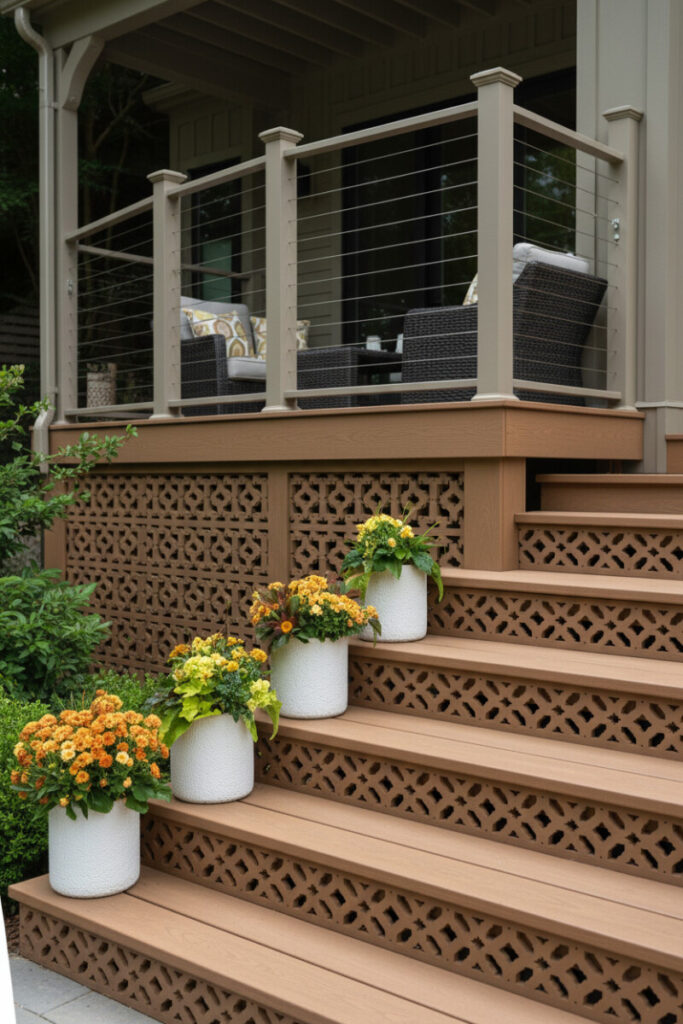
Laser-cut or routered lattice is not the humble garden panel of old. Modern geometric screens in composite or rot-resistant wood can deliver intricate Moorish or quatrefoil patterns that read custom. Use them sparingly—skirting and select stair risers—so the pattern feels intentional rather than busy.
Color strategy: Let the lattice go one shade lighter than the deck boards to reveal the cutwork. At night, slip a warm light wash behind the panels to project soft patterns onto adjacent surfaces. This is an excellent moment to elevate backyard deck design with a small flourish that still provides ventilation.
10. Faux Stone Panels
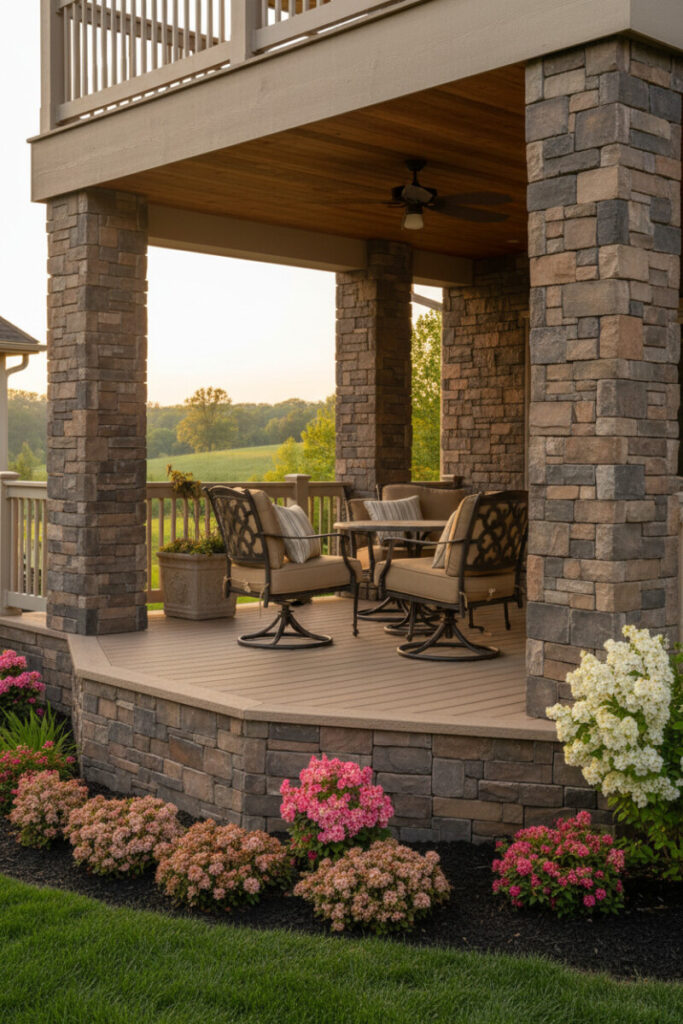
High-quality stone veneer panels have come a long way, offering deep texture without the weight or cost of full masonry. When you clad support columns and skirt wraps in the same profile, the deck feels grounded—literally—like a covered terrace. Choose mixed tones (tans, charcoals, a trace of rust) to bridge between house siding and landscape stone.
Installation: Use manufacturer-approved moisture barriers and backer boards. Finished edges matter; integrate corner pieces or full-return ends so the cuts never show. A perimeter bed of shrubs softens the vertical plane and hides the base rail.
11. Green Plants
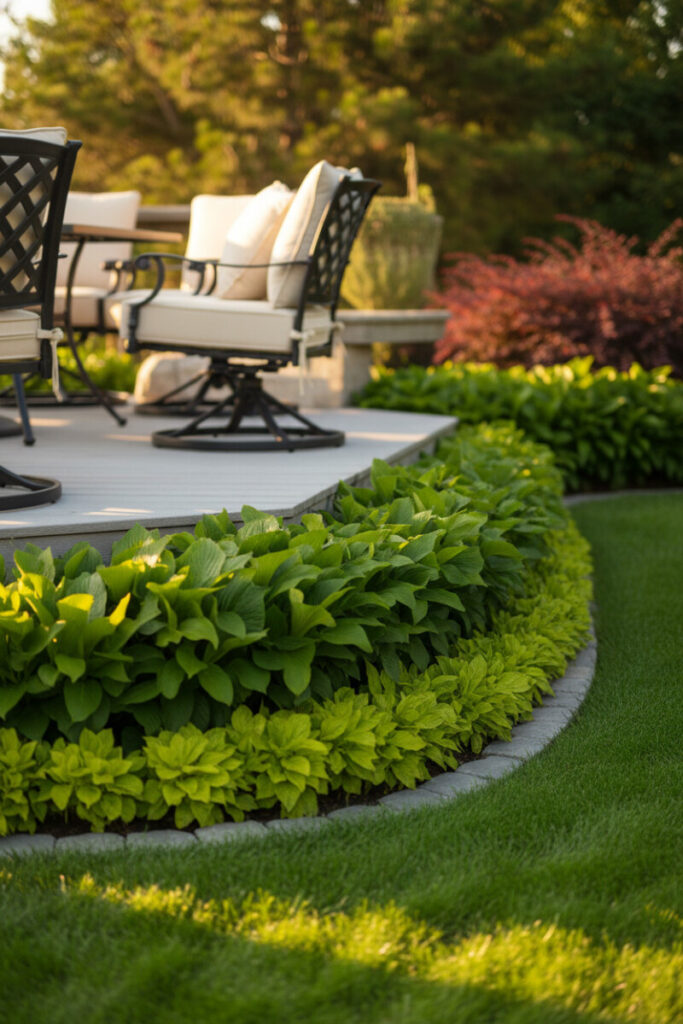
Sometimes the best deck skirting ideas grow. A dense planting bed—chartreuse mounds up front, darker foliage behind—builds a living, layered base that changes with seasons. Curved stone edging keeps the line clean and protects the bed from turf creep.
Planting notes: Pick low-maintenance varieties with different leaf textures so the palette stays interesting even when flowers fade. Drip irrigation tucked under mulch saves water and keeps foliage clean. In full sun, waxy leaves throw spectacular highlights at golden hour—nature doing the styling for you.
12. Horizontal Planks
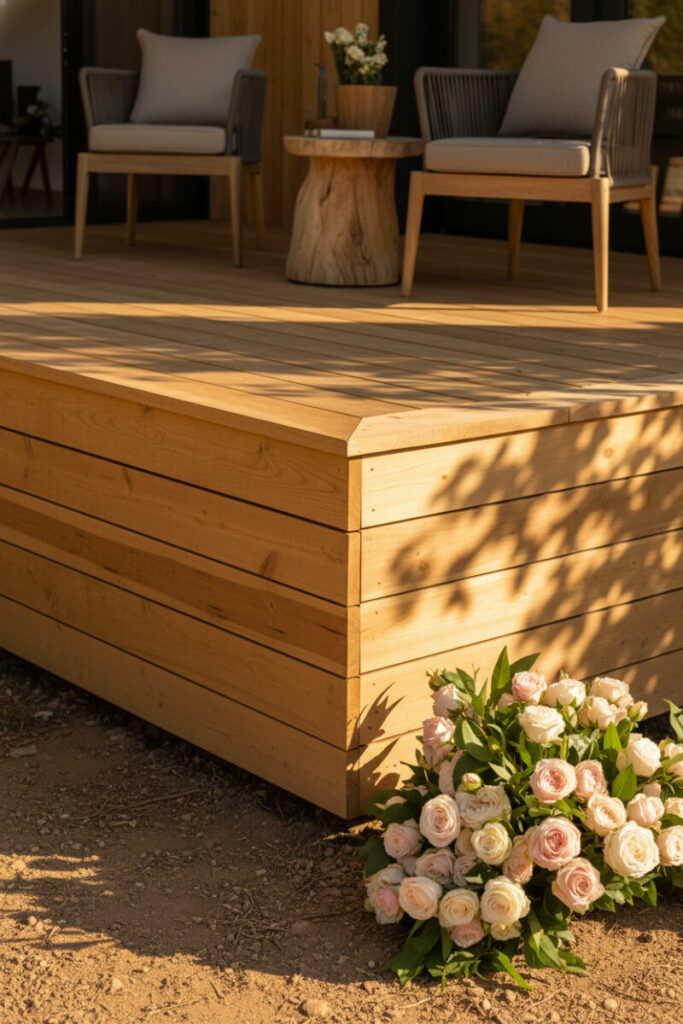
Stacked horizontal cedar or cypress planks read contemporary and warm. Keep the reveals tight (⅛–¼ inch) for a shadow-line effect that emphasizes length. If your deck corner is a visual focus, wrap the planks with beveled returns and run fasteners in a clean, consistent pattern for a furniture-grade look.
Finish: A clear UV sealer preserves the blonde tone; if you prefer a Scandinavian fade, leave it to weather to soft silver and simply re-seal annually. A small flourish—a bouquet, planter, or sculptural stool—against the planked face gives scale without clutter.
13. Light Wood Deck Skirting
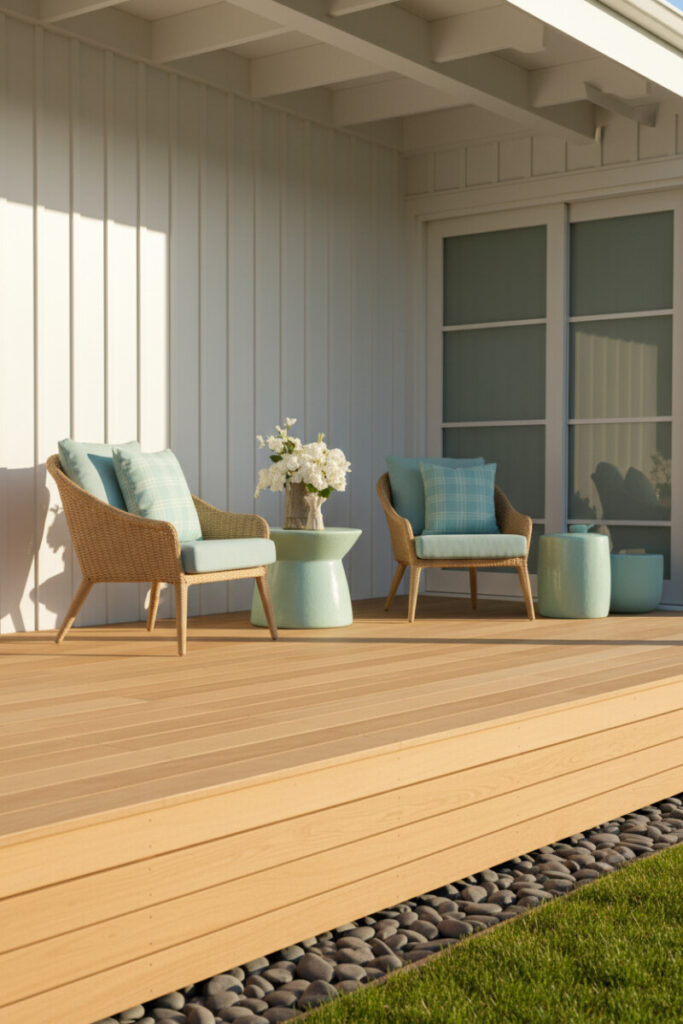
For coastal or breezy lake-house vibes, use pale, fine-grained boards with a tight groove texture. Three clean courses of skirting above a bed of smooth river stones create a calm horizon line. Pair with wicker lounge chairs, powdery blue cushions, and crisp white shiplap or siding for a palette that photographs beautifully at any hour.
Longevity tip: Light woods reflect heat, so they tend to move less. Still, leave expansion gaps and ventilate the void to prevent trapped humidity. A mint-glazed side table or pastel accent is enough color; let the wood and stone carry the scene.
14. Low-Profile Deck Skirting
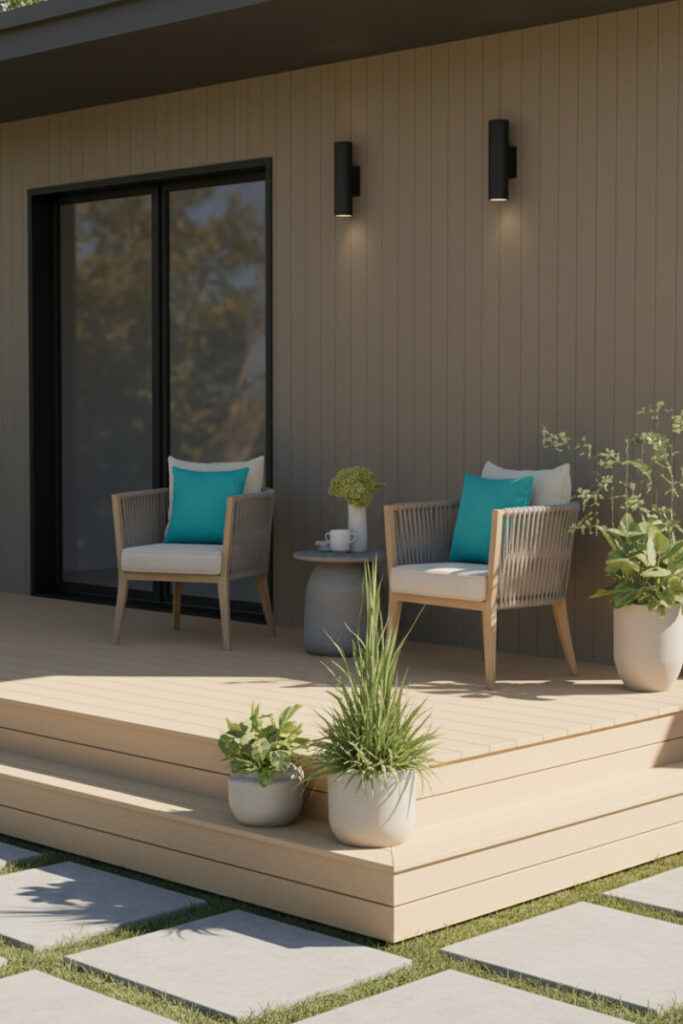
When a deck sits just a step or two above grade, a low-profile skirt in warm beige composite quietly tidies the base. The trick here is restraint: keep the height narrow and the lines sharp, then transition to a simple grid of concrete steppers set in turf. The negative space between stones doubles as drainage and breaks up a sea of paving.
Lighting & hardware: Minimal fixtures, minimal fuss. Two slender wall sconces near the sliders—and that’s it. The low skirt becomes a subtle plinth for the architecture rather than a feature competing with it.
15. Metal Lattice
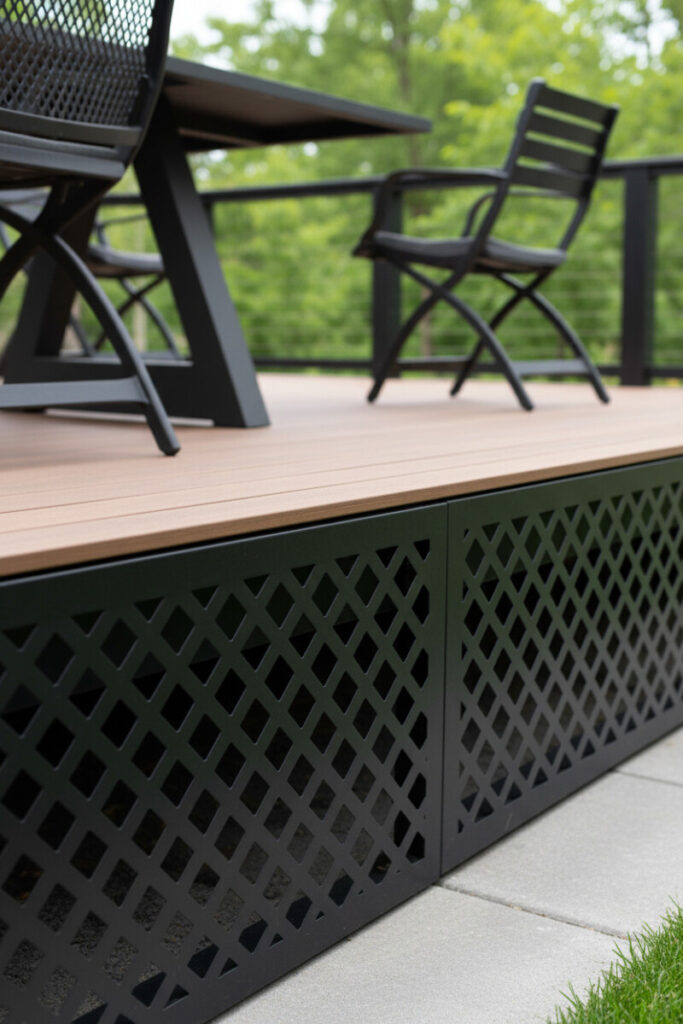
Matte black metal lattice—diamond-cut and rigid—delivers modern edge with unbeatable durability. Unlike wood lattice, it won’t sag. The diamond geometry contrasts with horizontal deck boards, and because the openings are small, it provides airflow while still discouraging critters.
What to watch: Non-reflective coatings keep the panels from picking up sky glare. Frame the lattice in the same black for a monolithic look, or in cedar for a warmer, mixed-material statement. Maintain a weed-barrier gravel strip to keep the void behind tidy.
16. Modern Deck Skirting
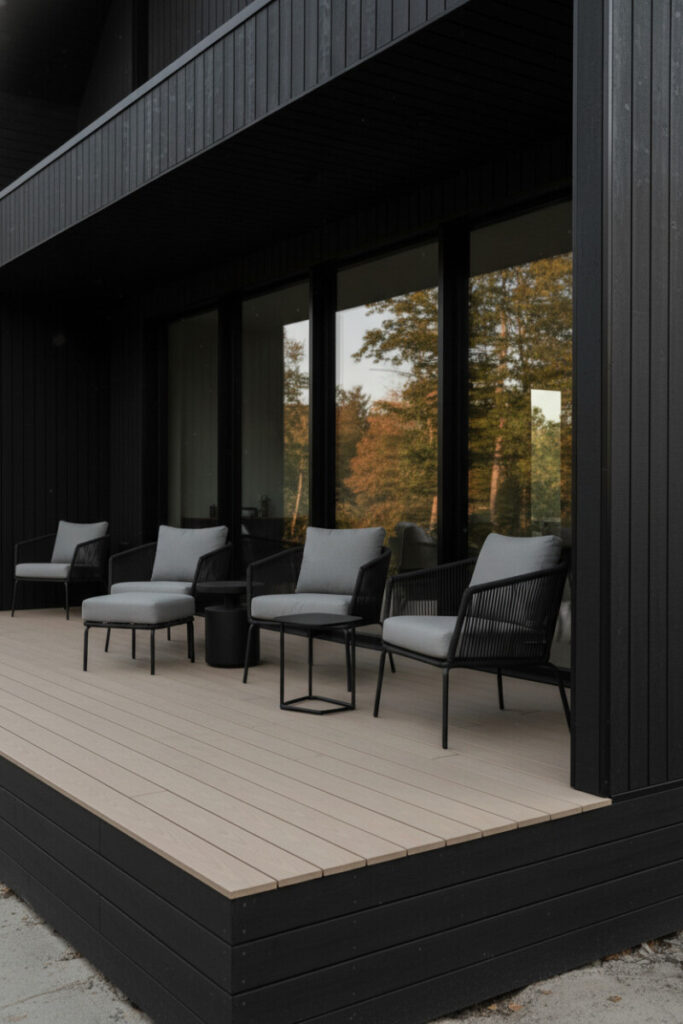
If your architecture skews sleek—black cladding, large glass, deep overhangs—echo that minimalism with horizontal aluminum planks in charcoal. The look is razor-clean. Wide, lightly textured composite deck boards in beige or sand add contrast and prevent the space from feeling heavy.
Furnishings: Stick to two or three materials (rope, aluminum, canvas), and let volumetric evening light do the rest. The skirt’s job here is to underline the geometry, not to shout.
17. Raised Deck Skirting
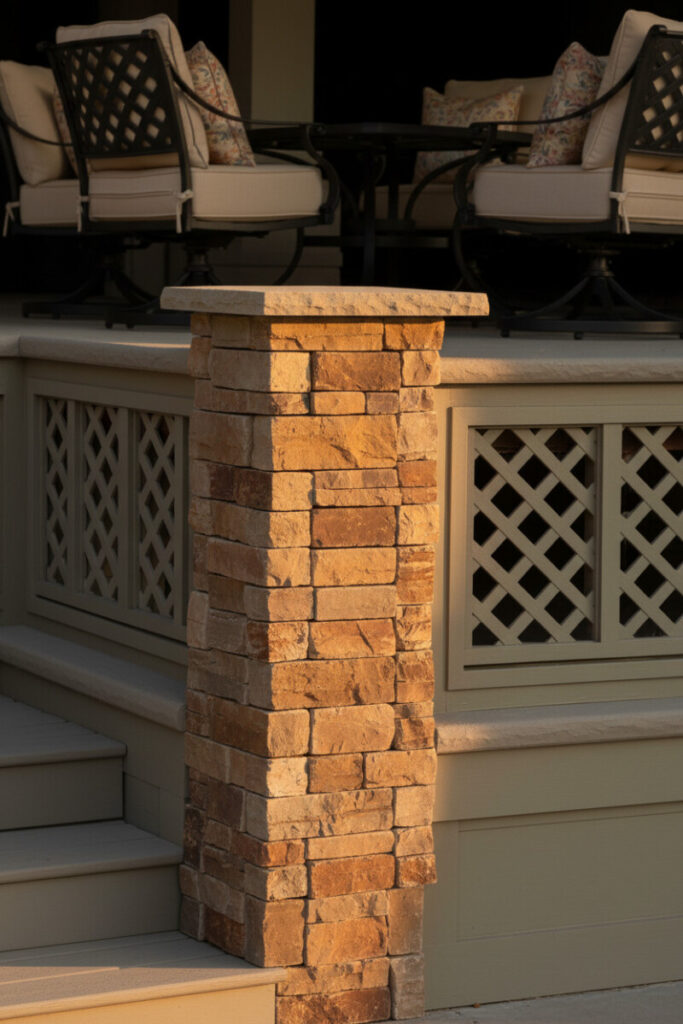
Tall decks need proportion, not just coverage. Combine paneled framing painted in a soft sage-taupe with decorative lattice infill and a statement stone pillar at the corner. The result feels crafted rather than utilitarian. Broad composite steps in muted gray lead the eye up, while the stone column anchors the structure to the ground.
Construction note: Break the vertical height into sections with a lower rail and cap to maintain stiffness and avoid oil-canning. On sloped sites, step the panels with grade so the lines remain level to the eye.
18. Stone Veneer
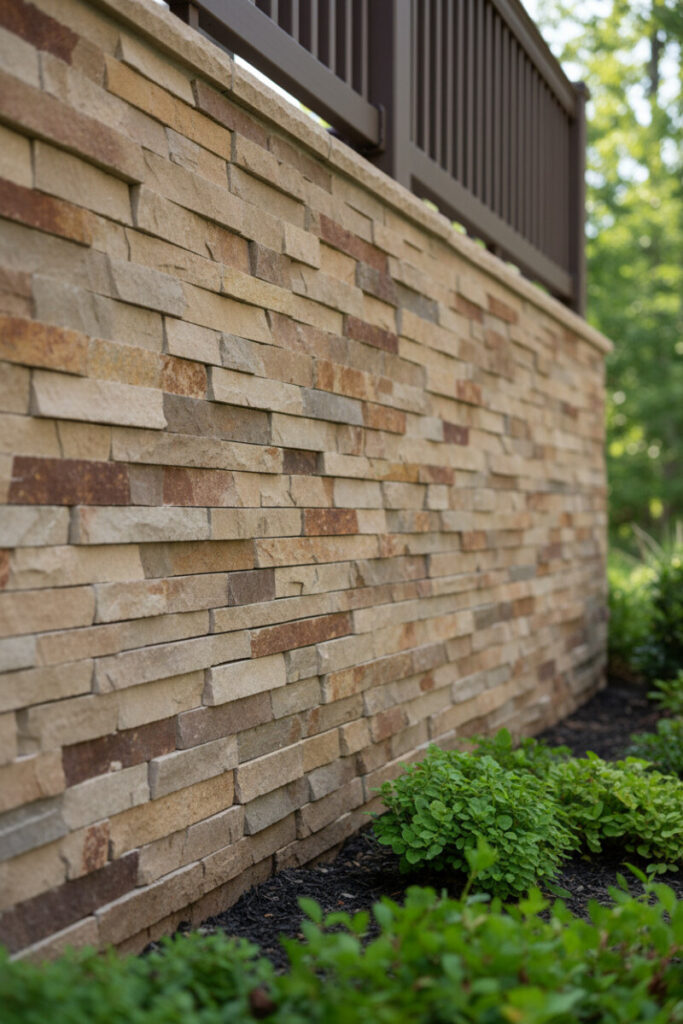
Dry-stacked stone veneer—thin, irregular strips—adds tons of texture in a small depth. It’s especially good for long runs where a uniform panel could look flat. A dark brown top rail or cap cleans up the transition to the deck rail, and a lush green groundcover at the base keeps the look soft.
Detailing: Stagger joint lines and avoid repeating pieces in a visible rhythm. With stone, randomness is the craft. Diffused daylight is your friend; it lights every ridge and recess like a relief sculpture.
19. Vertical Slats
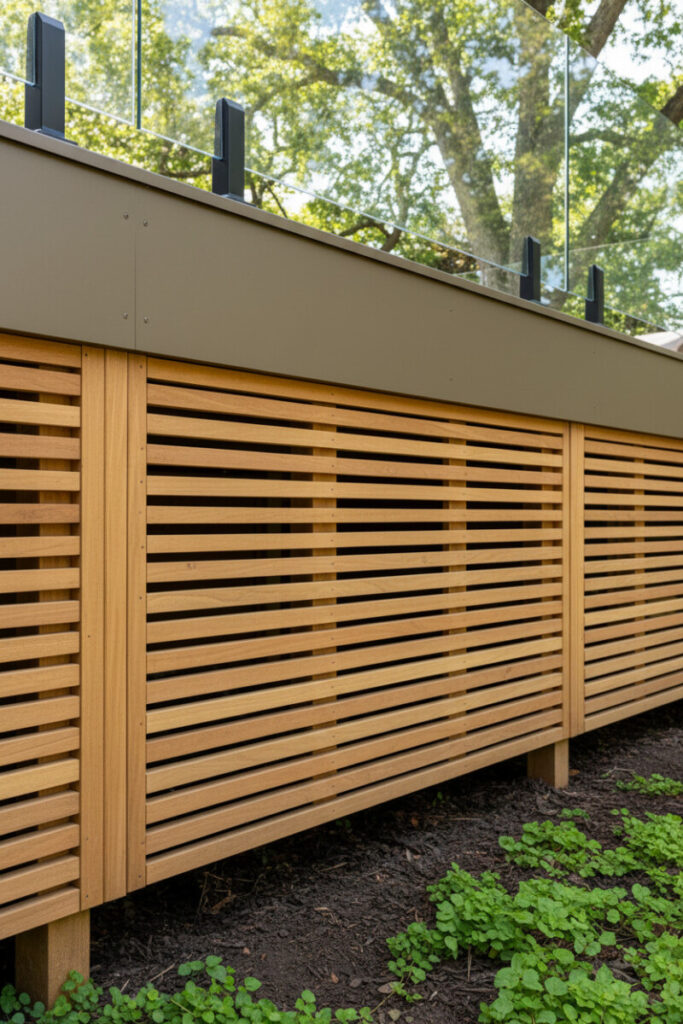
Vertical cedar or teak slats read tall, airy, and resolutely modern. The rhythm of narrow boards with small, consistent gaps creates subtle transparency—enough to breathe, not enough to expose clutter. A bronzed fascia above and frameless glass balustrade on top complete the elevated, gallery-like feel.
Build smart: Space slats at ⅜–½ inch with stainless brads or screws from the back side of a hidden ledger. The geometry rewards precision; take time to align end grains and use templates for spacing. This is also one of the best low-maintenance deck skirting options if you choose factory-finished hardwoods.
20. Vinyl Deck Skirting
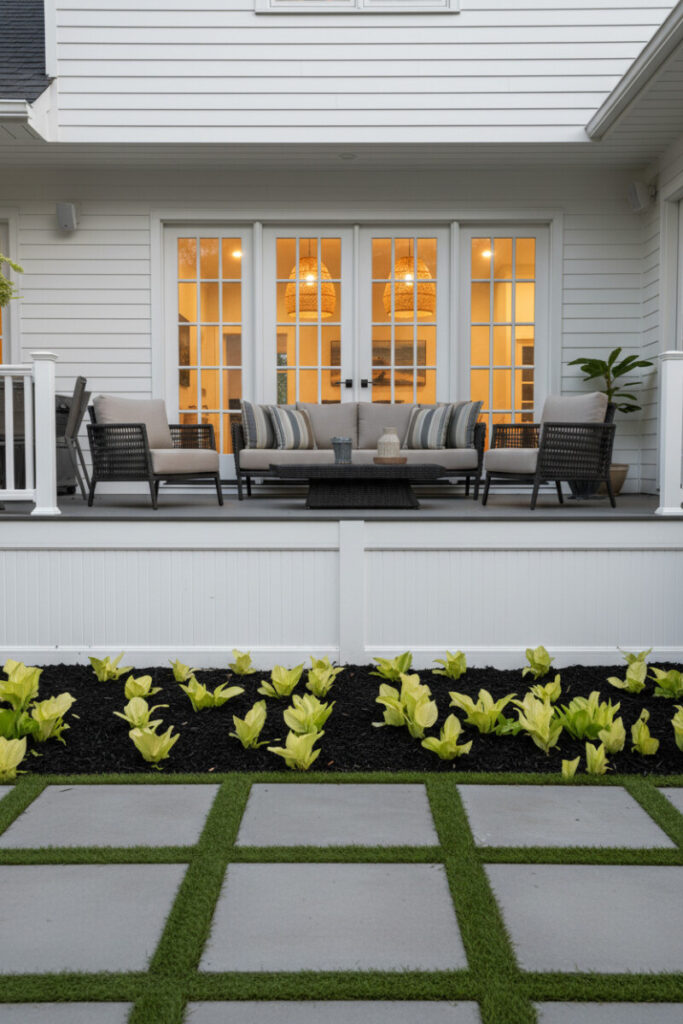
White vertical vinyl panels are a staple for traditional homes because they’re clean, crisp, and low effort. They resist moisture, insects, and sun, and a quick hose rinse brings them back to bright. Against black mulch and chartreuse foliage, vinyl pops, which is handy when you want the house to look freshly painted year-round.
Design trick: Pair vinyl skirting with dark composite decking above to avoid a “washed out” facade. Geometric paver grids with strips of turf add structure underfoot and pick up the vertical rhythm of the panels.
21. White Diamond Lattice
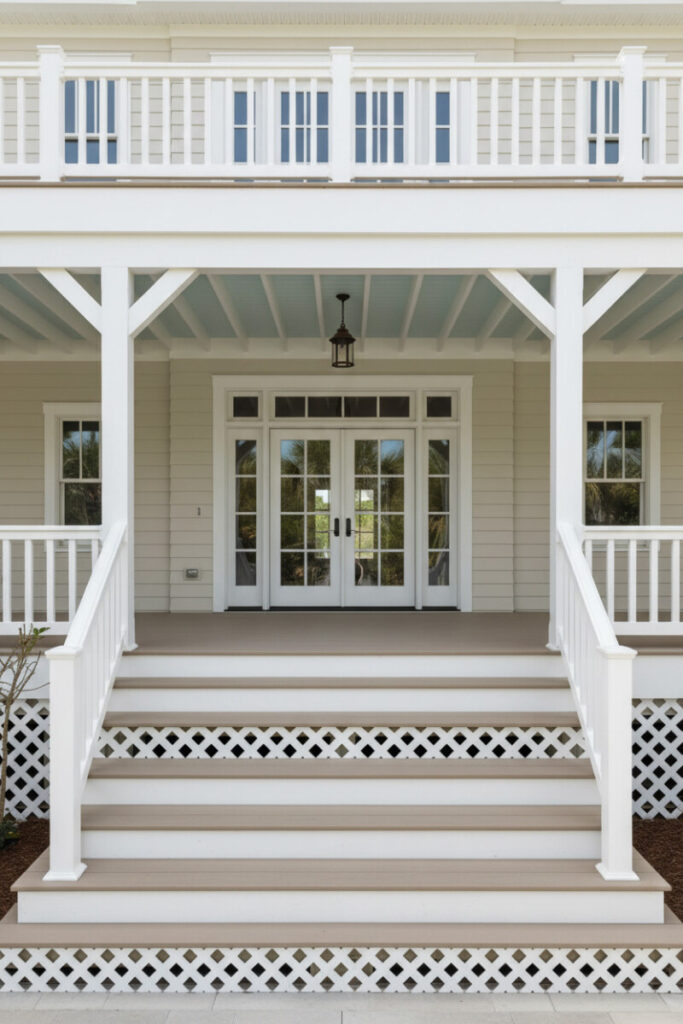
Classic coastal, farmhouse, or Southern porch? White diamond lattice is your pattern. When it repeats under stair risers as well as the main skirt, it creates a cadence that leads the eye to the front door. The key is craft: tight miters, centered patterns at corners, and a sturdy frame so the panels don’t flex.
Lighting & hardware: A single dark bronze pendant or gas-style lantern looks fantastic above white work. Consider black window grilles for contrast; the echo of small diamonds below and small panes above ties everything together.
22. Wooden Trellis Panels
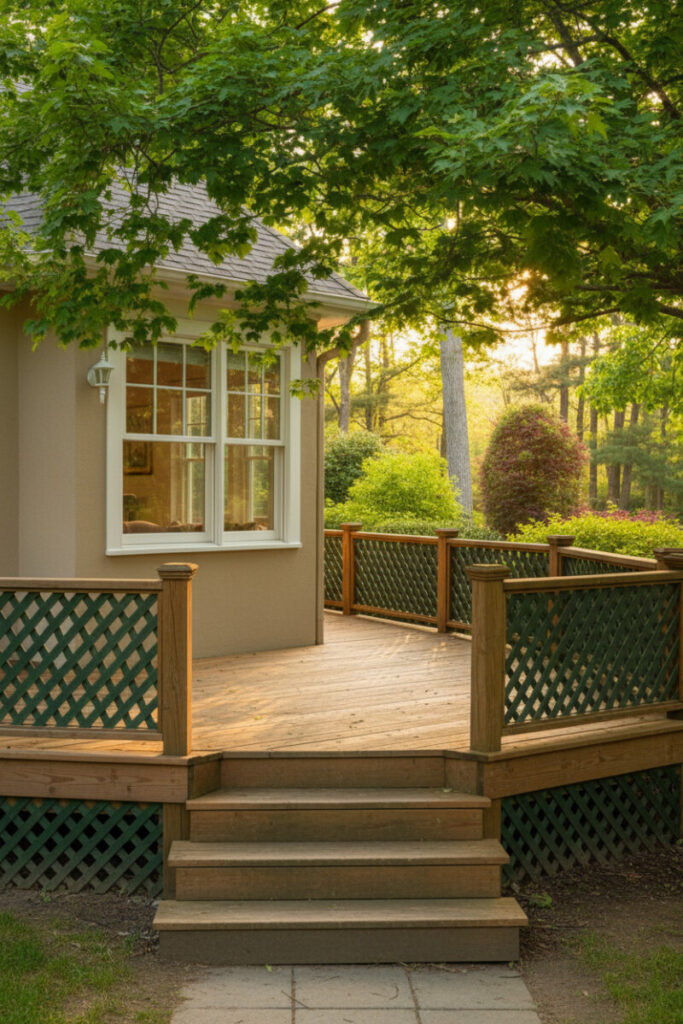
Trellis panels pull double duty as skirting and railing infill. In a deep forest-green stain, they blend effortlessly with surrounding plantings and add a cottage warmth without looking twee. Because the lattice is structural within the railing bays and repeated below, the composition feels cohesive.
Sun & shade: At golden hour, trellis panels throw delicate shadows across the steps—a small but delightful payoff. Keep the under-deck space tidy with gravel and a leaf barrier so glimpses through the diagonal lattice always read intentional.
How to Choose Among These Deck Skirting Ideas (A Practical Mini-Guide)
- Climate & maintenance: Composites, metal, and vinyl are your “set it and forget it” options. Natural wood is rewarding but asks for seasonal care. Stone and brick are essentially permanent but cost more upfront.
- Ventilation: Whatever you pick, plan for airflow. A continuous vent strip, spaced slats, or decorative screens prevents moisture buildup and preserves joists.
- Access: Expect to get under the deck at some point. Integrate removable panels or doors from the start.
- Critter control: Pair any open design with buried hardware cloth at grade. It disappears visually but stops skunks, raccoons, and curious neighborhood cats.
- Budget ranges (very general): Vinyl and corrugated metal are typically cost-effective; composite sits mid; hardwood slats, masonry, and custom panels trend higher. If costs creep, mix materials—say, stone on visible corners, composite in the runs. That’s one of the smarter budget-friendly deck skirting ideas that doesn’t feel like a compromise.
- Lighting: Even a modest lighting plan multiplies nighttime use. Favor warm temperatures and shield fixtures to avoid glare off glass doors.
Final Thoughts
Skirting is where architecture meets landscape. Pick a treatment that solves your practical needs—venting, storage, critter control—while echoing your home’s style language. Whether you lean traditional with white diamond lattice, lean modern with matte-black metal, or bring the garden up close with layered plantings, these 22 approaches are versatile enough to tailor to almost any backyard. And remember: details at the base set the tone for everything above.
